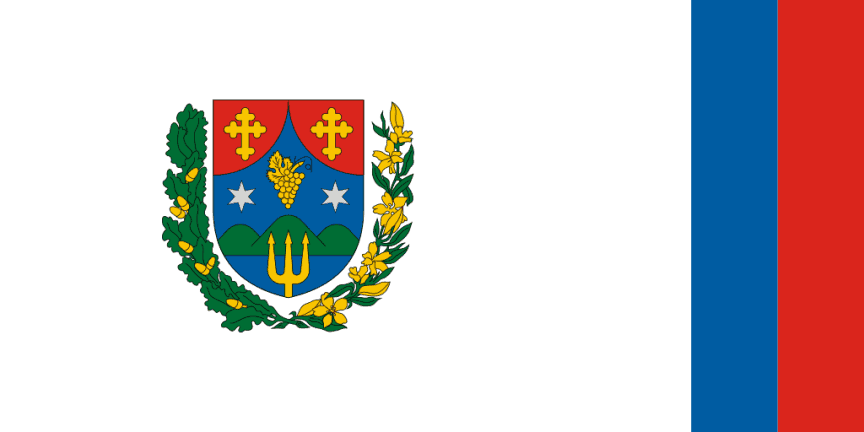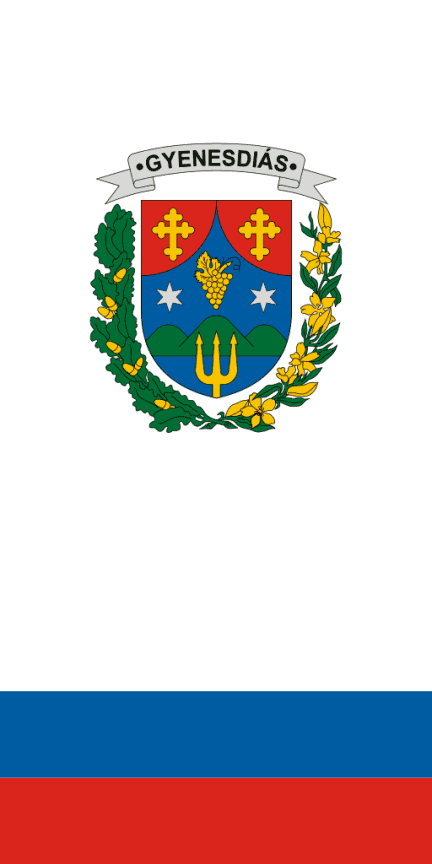 (1:2)
(1:2)image by Zoltan Horvath, 03 February 2025

Last modified: 2025-02-07 by zoltán horváth
Keywords: gyenesdias | zala | hungary |
Links: FOTW homepage |
search |
disclaimer and copyright |
write us |
mirrors
 (1:2)
(1:2)
image by Zoltan Horvath, 03 February 2025
See also:
Gyenesdiás is a large village in Keszthely district of Zala County, is located on the north shore of Lake Balaton, next to the town of Keszthely.
The area of Gyenesdiás became an important Roman settlement from the 1st century, and then Avars moved here.
In the Middle Ages, the first settlement to be established in the area of today's large village was Falud,
which probably existed in the 11th century on the northwestern border of today's Gyenesdiás. Its first church dates from 1333,
which is also the first written mention of the village. From 1408 it was the property of the Rezi castle, and then in 1427 it came to the Pethő family,
which also resulted in the settlement's strong connection to Keszthely.
In 1548, the Turks burned the settlement, the population dwindled, and by 1686 it was completely depopulated.
In 1696, a new settlement appeared on the Falud vineyard hill: Gyenes. During the 18th century, Falud and Gyenes came into the possession of the Festetics family.
By the end of the century, Gyenes had become a significant village, and by the 1820s it was already a functioning mountain village.
The village of Diás lays in the eastern part of Gyenesdiás in the Middle Ages, the first mention of which dates back to 1341.
By the 1530s, the settlement consisted only of noble estates, and most of its area was covered with vineyards.
In the 17th century, it was already a mountain village, primarily farmers from Keszthely cultivated grapes.
Gyenes and Diás merged in 1840, thus creating the independent municipality of Gyenesdiás.
Zoltan Horvath, 03 February 2025
The flag of the settlement is white with two vertical stripes at the fly, blue and red.
The coat of arms is placed in the white part of the flag from one-third of length from the hoist. The flag ratio is 1:2.
The flag was adopted by Local Government Decree 14/2013. (IV. 24.) issued on 24 April 2013.
https://or.njt.hu/onkormanyzati-rendelet/2013-14-SP-2818
Annex 2 of Decree shows images of horizontal and vertical flag.
Zoltan Horvath, 03 February 2025
 (1:2)
(1:2)
image by Zoltan Horvath, 03 February 2025
It has the same elements, but coat of arms is also rotated with 90 degrees upwards.
While the coat of arms is depicted without silver ribbon over the shield on the horizontal version, the vertical variant charged with full coat of arms.
Zoltan Horvath, 03 February 2025
za-gy.gif)
image by Zoltan Horvath, 03 February 2025
The coat of arms is a blue shield, the upper part of which is red (three times curved in the upper section) and the lower part is green.
In each red field, a golden cross float. In the blue part, between two six-pointed silver stars, a golden, leafy grape cluster is depicted.
In the middle of the shield base, reaching to the upper curve of the sash, a three-pointed, golden harpoon rises.
The shield is surrounded on the right by a golden oak tree with fruit, and on the left by an almond branch with golden flowers.
The coat of arms was adopted by the same Local Government Decree.
Image of coat of arms:
Annex 1 of Decree shows image of coat of arms.
https://www.gyenesdias.hu/hu/ (website of settlement)
Zoltan Horvath, 03 February 2025
za_gy.gif)
image by Zoltan Horvath, 03 February 2025
The logo is a marketing tool that supports both tourism and settlement marketing goals, primarily serving the uniform appearance of publications,
advertisements, promotional and handout materials, and souvenirs presenting the tourist offer of the large village.
The logo depicts the shore of Lake Balaton from the water with sunset and a sailing boat. Under the scene, the name of the settlement is written,
while under the name the inscription 'Nyugat-Balaton üdülőfaluja' (Resort village of Western Balaton) can be read.
Annex 3 of Decree shows image of logo.
https://www.gyenesdias.info.hu/
Zoltan Horvath, 03 February 2025